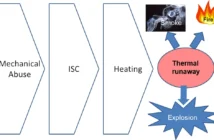Energy density in a battery is defined as the amount of usable stored energy.
Energy density relates the mass to the volume of the energy storage-device. This means, a large energy storage does not equate a high energy density. The weight of that energy storage is also considered. For example, a battery with a 10 ml capacity and a weight of 1 g has a higher energy density compared with a battery with 100 ml capacity with the same weight. The former is more compact.
When a battery has a higher energy density, more energy can be stored in the same amount of space.
Here are examples of storage devices, its common applications, and their corresponding specific energy and energy density.
|
Storage Device |
Common Applications |
Energy Density (MJ/L) |
| Laptop computers, mobile devices, modern electric vehicles |
0.9-2.63 |
|
| Portable electronic devices, flashlights |
1.8 |
|
| Portable electronic devices, flashlights |
0.504-1.08 |
|
| Automotive engine ignition |
0.34 |
Among those listed above lead acid battery has the lowest energy density. It could not be used in handheld and compact devices.
From this table, the lithium-ion battery has the highest energy density because it could store a large amount of energy in a small volume. Because the energy storage is compact, it is ideal to use in portable devices such as laptops and phones.
Related Articles
How to Calculate Battery Capacity
Latest Flexible Supercapacitor with a Higher Volumetric Energy Density



